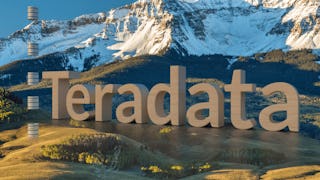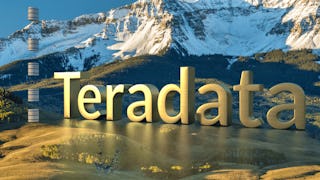Fundamentals of Teradata: Architecture, Storage & Operations Course provides a comprehensive introduction to Teradata, covering its architecture, relational concepts, indexing, join strategies, data types, and storage mechanisms. Participants will gain a deep understanding of Teradata's components, their interactions, and how data is stored, retrieved, and manipulated within the system. Additionally, the course explores best practices for data type selection, storage optimization, and error prevention. Through theoretical learning and practical case studies, participants will acquire essential skills for effective Teradata utilization.
通过 Coursera Plus 解锁访问 10,000 多门课程。开始 7 天免费试用。


您将学到什么
Identify key components of Teradata architecture and explain their roles in data management.
Describe how Teradata components collaborate for efficient data storage, retrieval, and manipulation.
Evaluate different indexing and join strategies used in Teradata for optimizing data processing.
Utilize knowledge of Teradata data types and storage mechanisms to optimize performance and prevent common errors.
您将获得的技能
要了解的详细信息
了解顶级公司的员工如何掌握热门技能

积累特定领域的专业知识
- 向行业专家学习新概念
- 获得对主题或工具的基础理解
- 通过实践项目培养工作相关技能
- 获得可共享的职业证书

该课程共有3个模块
Module 1: Introduction to Teradata provides a comprehensive foundation in Teradata fundamentals. Learn about Teradata's essence, its architecture, and basic relational concepts essential for database management. Understand its competitive advantages over other RDBMS. Delve into the intricate components of Teradata, their interactions, and their role in data storage and retrieval. Gain insights into Teradata's connectivity with mainframe and network applications, empowering you with essential knowledge to navigate the Teradata environment effectively.
涵盖的内容
12个视频3篇阅读材料3个作业1个讨论话题
In this module learners will delve into the intricacies of indexing, starting with an elucidation of the difference between primary keys and primary indexes. This module shifts its focus to Teradata Join Strategies. learners will explore various strategies employed by Teradata to optimize table joining processes. This includes a detailed examination of join strategies, such as inner and outer joins, utilized by Teradata to efficiently merge data from multiple tables. Additionally, learners will delve into the concept of partition primary index (PPI) tables and understand how data is redistributed for join processing, ensuring optimized performance and data integrity.
涵盖的内容
10个视频2篇阅读材料3个作业
Module 3: Data Types and Storage provides a detailed exploration of essential components vital for proficient data management within Teradata. learners will embark on an in-depth journey into Teradata data types, unraveling their intricacies, storage nuances, and optimal selection strategies. Moreover, learners will delve into the complexities of data storage and retrieval mechanisms within Teradata systems, understanding the inner workings of storage architectures and employing optimization techniques for enhanced performance. Through practical insights and theoretical foundations, learners will acquire the expertise needed to navigate diverse data types effectively and optimize storage solutions within Teradata environments.
涵盖的内容
11个视频2篇阅读材料3个作业1次同伴评审
获得职业证书
将此证书添加到您的 LinkedIn 个人资料、简历或履历中。在社交媒体和绩效考核中分享。
位教师

从 Software Development 浏览更多内容
 状态:免费试用
状态:免费试用LearnQuest
 状态:免费试用
状态:免费试用Board Infinity
 状态:免费试用
状态:免费试用Board Infinity
 状态:免费试用
状态:免费试用LearnQuest
人们为什么选择 Coursera 来帮助自己实现职业发展




常见问题
To access the course materials, assignments and to earn a Certificate, you will need to purchase the Certificate experience when you enroll in a course. You can try a Free Trial instead, or apply for Financial Aid. The course may offer 'Full Course, No Certificate' instead. This option lets you see all course materials, submit required assessments, and get a final grade. This also means that you will not be able to purchase a Certificate experience.
When you enroll in the course, you get access to all of the courses in the Specialization, and you earn a certificate when you complete the work. Your electronic Certificate will be added to your Accomplishments page - from there, you can print your Certificate or add it to your LinkedIn profile.
Yes. In select learning programs, you can apply for financial aid or a scholarship if you can’t afford the enrollment fee. If fin aid or scholarship is available for your learning program selection, you’ll find a link to apply on the description page.
更多问题
提供助学金,
¹ 本课程的部分作业采用 AI 评分。对于这些作业,将根据 Coursera 隐私声明使用您的数据。




